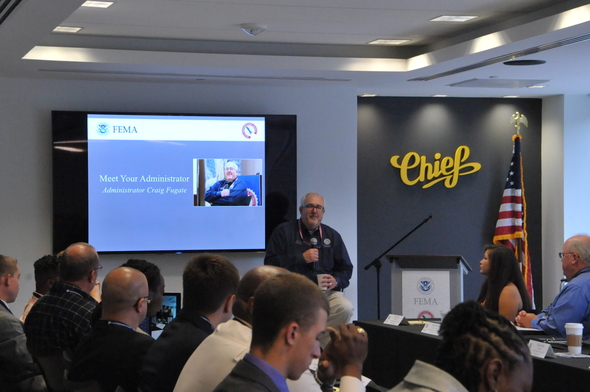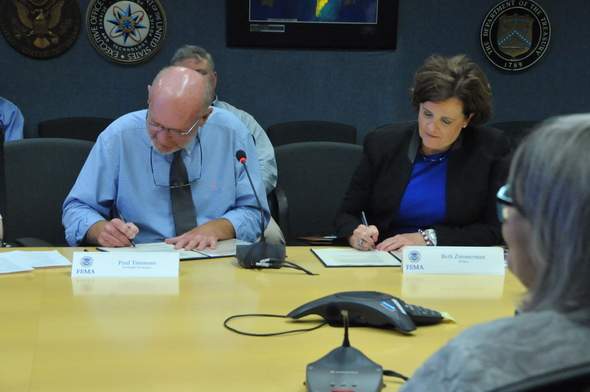|
Predicting a disaster is not an exact
science, but no emergency manager or local official wants to be in the middle
of a disaster asking, “What do we do?” Preparing for tomorrow’s disasters must
include training personnel from all levels of government to increase
coordination and response during a real emergency. FEMA's Emergency Management Institute’s (EMI) Integrated Emergency Management
Course (IEMC) provides just this type of training to help emergency managers
and local officials prepare for future disasters.
Sixty officials from Georgia’s Macon-Bibb
County traveled to Emmitsburg, Maryland, to participate in a four and a
half day exercised-based IEMC from July 20-23.
The community specific IEMC courses help increase
the skills of participating officials and provide a forum to evaluate the
effectiveness of their specific emergency policies, plans, and procedures
to protect life and property in the event of a disaster. IEMC places elected
officials, including emergency managers, city and county department heads, and
people who work in utilities, health care, education, transportation, or volunteer organizations in simulated situations
within a structured learning environment.
The Macon-Bibb County officials trained
together as a team at EMI. They learned new ways to coordinate with other local
agencies and organizations in their area through classroom lectures, discussions,
small-group planning sessions, and exercises. The training allowed the team to
rehearse their real life roles in a realistic emergency situation, while
helping them to identify additional planning needs. Each IEMC course addresses leadership and policy
based decision making as well as the functional aspects of an Emergency
Operations Center. In addition to the core capabilities, each IEMC uses one
or more of the 15 National Planning Scenarios which were developed by the
Department of Homeland Security to highlight a plausible range of major events
that pose the greatest risk to the nation.
Protecting the American people is the primary
responsibility of government, but maintaining the high standards and readiness
of state, local, tribal, and territorial officials who can operate in an
emergency requires training, healthy relationships, and the successful
coordination of a community emergency team. FEMA EMI’s Integrated
Emergency Management Course program enables emergency managers and other officials to respond
in a more effective way when a disaster occurs.
To learn more about how city or county officials can
participate in the IEMC training, contact EMI’s Integrated Emergency Management
Section staff at 301-447-1381 or visit www.training.fema.gov/iemc. For information on other EMI training courses,
visit www.training.fema.gov/emi/aspx.
 Emmitsburg, MD--Mayor A.B. Reichert and Macon-Bibb County Commissioner Al Tillman participate in the IEMC training course at the Emergency Management Institute on the campus of the National Emergency Training Center.
FEMA hosted
the FEMA Youth Preparedness Council Members during the 2015 Youth Preparedness
Council Summit on July 21-22, 2015. Council members were invited to share their
ideas, opinions, and questions about youth disaster preparedness with
leadership of national organizations working on this critical priority. As part
of the summit, members met with Administrator Craig Fugate and participated in a
panel discussion with leaders from different FEMA divisions including National
Preparedness, External Affairs, the National Advisory Council, Recovery, and
DHS Center for Faith-based and Neighborhood Partnerships.
During the
summit, FEMA met with Hailey Starr, one of the Council members and a member of the Muckleshoot tribe in the state of Washington, to learn more
about how she was working to promote youth preparedness in her community. Her
projects include producing an active shooter awareness video, creating
emergency preparedness kits for community elders, and coordinating a
shelter-in-place emergency management exercise. More about Hailey’s work can be
read on the FEMA blog.
Created in
2012, the Council brings together youth leaders from across the country that
are interested in advocating on behalf of youth preparedness and making a
difference in their communities. Members have to fill three main
responsibilities: completing a self-selected legacy project, acting as an
ambassador for youth preparedness, and liaising to FEMA on the youth
perspective. More information about the Youth Preparedness Council is available
online at www.fema.gov/youth-preparedness-council.
 FEMA Administrator Craig Fugate meets with the FEMA Youth Preparedness Council during their annual summit.
August 2015 marks the tenth year since the devastating 2005 Atlantic
Hurricane Season. According to the National Oceanic and Atmospheric
Administration (NOAA), Hurricane Katrina was one of the strongest storms to
impact the coast of the United States, causing widespread devastation and
affecting an estimated 90,000 square miles along the central Gulf Coast states.
Less than a month later, Hurricane Rita and then Hurricane Wilma in October
made landfall compounding an already catastrophic situation.
Ten years into the recovery, FEMA continues to support communities and
families, working side-by-side with state, local, and tribal partners to finish
the job of rebuilding communities that are the economic engines and lifeblood
of the Gulf Coast. To date, FEMA has provided $6.7 billion to more than one
million individuals and households. FEMA provided more than $131 billion
to the states of Louisiana, Mississippi, Alabama, and Florida for public works
projects in the aftermath of Hurricane Katrina to assist with recovery efforts.
For more information on FEMA’s continued work to
support communities and families along the Gulf Coast, visit our Hurricane
Katrina: A Decade of Progress Through Partnerships website.
On July 30,
2015, FEMA and Portlight Strategies
(Portlight) announced an agreement that will increase preparedness
awareness for people with disabilities in the event of natural or man-made
disasters. The agreement aligns with FEMA’s commitment to inclusive emergency
management by partnering with disability organizations and community leaders
who serve the whole community at the local level.
The new
partnership will bolster working relationships with state, local, tribal, and
territorial emergency managers to encourage including people with disabilities
in planning. It will also provide information so people understand the
disaster risks in their area. By evaluating their own individual needs and
making an emergency plan that fits those needs, people can be better prepared.
Some key
highlights from the agreement show that FEMA and Portlight will:
- Participate
in training events and natural and simulation exercises, drills, and
discussions focused on emergency preparedness and lessening the impact of
disasters;
- Share
operational practices that work well and that may be adapted to make
improvements in service delivery and support community resilience and
accessibility for people with disabilities and others with access and
functional needs; and
- Share
research-based emergency management data and information and training experience
and expertise before, during, and after disasters.
As part of the
Americans with Disabilities Act (ADA) 25th anniversary, FEMA’s
Office of Disabilities and Integration Coordination (ODIC) director Marcie Roth
spoke at Portlight’s “Getting It Right” workshop on July 31. The workshop
provided tools to facilitate full integration and inclusion in all emergency
preparedness and response. More information about ADA and ODIC can be
found at www.ada.gov
and www.ready.gov/individuals-access-functional-needs.
 Beth Zimmerman, Associate Administrator, FEMA's Office of Response & Recovery, and Paul Timmons, CEO of Portlight Strategies, sign the Memorandum of Agreement.
FEMA's Emergency
Management Institute (EMI) conducts a monthly series of Virtual Tabletop
Exercises (VTTX) using a video teleconference platform to reach community-based
training audiences around the country and provide a virtual forum for disaster
training. The VTTX programs are designed for a community-based group of at
least ten or more personnel from local or state emergency management
organizations with representatives from other disciplines such as public
safety, public works, public health, health care, government, administrative,
communications, military, private sector, non-governmental, and other whole
community partners. Participants must have an appropriate site equipped with
video teleconference capability that can access FEMA.
EMI will conduct VTTX
programs between August and September 2015 on a variety of subjects:
- August 25-27, 2015:
Building Collapse Focused
- September 1-3, 2015:
Public Health Infectious Disease (written and hosted by the CDC)
To apply for a VTTX
event, submit an email request to participate in the exercise to Doug Kahn at douglas.kahn@fema.dhs.gov or call
301-447-7645. The deadline for applying to participate in a VTTX is four weeks
prior to the start date.
FEMA announced the release of the Notice of Funding Opportunity (NOFO), for the Fiscal Year (FY) 2015 Homeland Security National Training
Program (HSNTP) Continuing Training Grants (CTG) program with a total
$11,521,000 available for awards in four focus areas.
This highly competitive program attracts on average 80 applicants from
state, local, tribal, and territorial governments, along with eligible
non-profit organizations to include colleges and universities. In 2014,
88 eligible organizations competed and six HSNTP/CTG awards were made.
Information on the 2014 awards can be found online.
FY 2015 HSNTP/CTG applications are due no later than August 10,
2015 at 11:59 p.m. EDT. Submissions must be made through www.grants.gov.
FEMA announced $180 million
in funding available through two Hazard Mitigation Assistance (HMA) grant
programs: Flood Mitigation Assistance (FMA) and Pre-Disaster Mitigation (PDM).
These two grant programs assist state, local, tribal, and territorial
governments in strengthening our nation’s ability to reduce the potential cost of natural disasters to communities
and their citizens.
Both HMA FY 2015 Funding Opportunity Announcements can be
found at www.grants.gov. Eligible applicants must apply for funding through
the Mitigation eGrants system on the FEMA Grants Portal accessible at https://portal.fema.gov. All applications must be submitted no
later than August 28,
2015 at 3 p.m. EDT.
FEMA's HMA grant programs
provide states, local governments, tribes, and territories funding for eligible
mitigation activities to strengthen our nation’s ability to reduce disaster
losses and protect life and property from future disaster damages. Further
information on these grant programs is available at www.fema.gov/hazard-mitigation-assistance.
FEMA is
reminding National Flood Insurance Program (NFIP) policyholders, who filed a
claim as a result of Hurricane Sandy, that they have 60 days to register to
have their claim files reviewed if they believe their claims were underpaid. FEMA set a Sept. 15, 2015 as the last
day for policyholders to register.
FEMA is committed to ensuring every NFIP
policyholder who filed a claim as a result of Hurricane Sandy receives every
dollar they are due under their policy. The NFIP established a process for Hurricane Sandy survivors to have their
claims reviewed. Where warranted, additional
payments will be made to those policyholders. FEMA sent letters to approximately
142,000 NFIP policyholders who filed claims resulting from Hurricane Sandy,
offering them an opportunity to have their files reviewed. To date, more than
8,900 policyholders have joined the process.
To be eligible for the review, policyholders must
have experienced flood damage between October 27, 2012 and November 6, 2012 as a
result of Hurricane Sandy. Policyholders can call the NFIP’s Hurricane Sandy
claims center at 1-866-337-4262 to request a review. Alternately, policyholders can go online to www.fema.gov/hurricane-sandy-nfip-claims to download a form requesting a review.
The downloaded form may be filled out and emailed to FEMA-sandyclaimsreview@fema.dhs.gov
to start the review process. For individuals who are deaf, hard of hearing, or
have a speech disability using 711 or VRS, please call 866-337-4262. For
individuals using a TTY, please call 800-462-7585 to begin the review
process. Before contacting the claim center, policyholders are asked to
have their flood insurance carrier name and policy number at hand.
FEMA will request the policyholder’s claim file from
their insurance company and forward it to the NFIP review office within two
business days. Files will be assigned to a highly skilled, NFIP-certified
adjuster who will serve as a caseworker for the insured. The entire process
should take less than 90 days. Caseworkers will contact policyholders to guide
them through the review process. Additionally, there
are several nonprofit service providers ready to offer free advice and answer
questions policyholders may have. A list of these advocacy groups can be found
on the claims review website at www.fema.gov/sandyclaims.
Policyholders who have already registered for the
Hurricane Sandy claims review do not need to take any additional action and can
expect to be contacted by their caseworker.
|